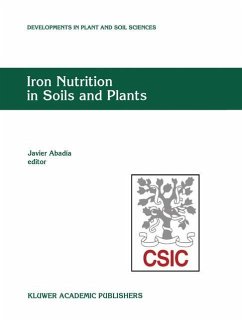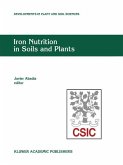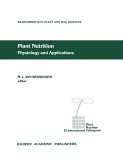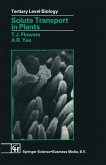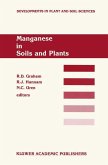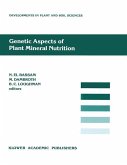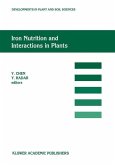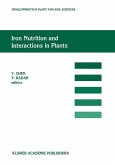Javier Abad¡a (Hrsg.)Proceedings of the Seventh International Symposium on Iron Nutrition and Interactions in Plants, June 27-July 2, 1993, Zaragoza, Spain
Iron Nutrition in Soils and Plants
Proceedings of the Seventh International Symposium on Iron Nutrition and Interactions in Plants, June 27-July 2, 1993, Zaragoza, Spain
Herausgegeben:Abadía, Javier
Javier Abad¡a (Hrsg.)Proceedings of the Seventh International Symposium on Iron Nutrition and Interactions in Plants, June 27-July 2, 1993, Zaragoza, Spain
Iron Nutrition in Soils and Plants
Proceedings of the Seventh International Symposium on Iron Nutrition and Interactions in Plants, June 27-July 2, 1993, Zaragoza, Spain
Herausgegeben:Abadía, Javier
- Gebundenes Buch
- Merkliste
- Auf die Merkliste
- Bewerten Bewerten
- Teilen
- Produkt teilen
- Produkterinnerung
- Produkterinnerung
Iron is a major constituent of the earth crust. However, under alkaline conditions commonly found in arid and semi-arid environments iron becomes unavailable to plants. When plants are affected by a shortage of iron their leaves become yellow (chlorotic), and both plant growth and crop yield are reduced. The roots of plants affected by iron deficiency may develop a series of responses directed to improve iron uptake, such as increased proton excretion and iron reduction capabilities or excretion of iron chela tors called siderophores. Iron deficiency affects major crops worldwide, including…mehr
Andere Kunden interessierten sich auch für
![Iron Nutrition in Soils and Plants Iron Nutrition in Soils and Plants]() Iron Nutrition in Soils and Plants229,99 €
Iron Nutrition in Soils and Plants229,99 €![Plant Nutrition - Physiology and Applications Plant Nutrition - Physiology and Applications]() M.L. Van Beusichem (ed.)Plant Nutrition - Physiology and Applications139,99 €
M.L. Van Beusichem (ed.)Plant Nutrition - Physiology and Applications139,99 €![Solute Transport in Plants Solute Transport in Plants]() T. J. FlowersSolute Transport in Plants39,99 €
T. J. FlowersSolute Transport in Plants39,99 €![Manganese in Soils and Plants Manganese in Soils and Plants]() R.D. Graham / R.J. Hannam / N.C. Uren (Hgg.)Manganese in Soils and Plants168,99 €
R.D. Graham / R.J. Hannam / N.C. Uren (Hgg.)Manganese in Soils and Plants168,99 €![Genetic Aspects of Plant Mineral Nutrition Genetic Aspects of Plant Mineral Nutrition]() Nasir El BassamGenetic Aspects of Plant Mineral Nutrition229,99 €
Nasir El BassamGenetic Aspects of Plant Mineral Nutrition229,99 €![Iron Nutrition and Interactions in Plants Iron Nutrition and Interactions in Plants]() Iron Nutrition and Interactions in Plants229,99 €
Iron Nutrition and Interactions in Plants229,99 €![Iron Nutrition and Interactions in Plants Iron Nutrition and Interactions in Plants]() ChenIron Nutrition and Interactions in Plants229,99 €
ChenIron Nutrition and Interactions in Plants229,99 €-
-
-
Iron is a major constituent of the earth crust. However, under alkaline conditions commonly found in arid and semi-arid environments iron becomes unavailable to plants. When plants are affected by a shortage of iron their leaves become yellow (chlorotic), and both plant growth and crop yield are reduced. The roots of plants affected by iron deficiency may develop a series of responses directed to improve iron uptake, such as increased proton excretion and iron reduction capabilities or excretion of iron chela tors called siderophores. Iron deficiency affects major crops worldwide, including some of major economic importance such as fruit trees and others. Correction of iron deficiency is usually implemented through costly application of synthetic chelates. Since these correction methods are very expensive, the competitivity of farmers is often reduced and iron deficiency may become a limiting factor for the maintenance, introduction or expansion of some crops. In spite of the many years devoted to the study of iron deficiency, the knowledge of iron deficiency in soils and plants is still fragmentary in many aspects. We have only incomplete information on the processes at the molecular level that make some plant species and cultivars unable to take and utilize iron from the soil, whereas other plants grow satisfactorily under the same conditions.
Produktdetails
- Produktdetails
- Developments in Plant and Soil Sciences 59
- Verlag: Springer / Springer Netherlands
- Artikelnr. des Verlages: 978-0-7923-2900-8
- Reprinted from PLANT AND SOIL, 165:2, 1995
- Seitenzahl: 416
- Erscheinungstermin: 28. Februar 1995
- Englisch
- Abmessung: 260mm x 183mm x 27mm
- Gewicht: 1007g
- ISBN-13: 9780792329008
- ISBN-10: 0792329007
- Artikelnr.: 23085690
- Herstellerkennzeichnung
- Springer-Verlag GmbH
- Tiergartenstr. 17
- 69121 Heidelberg
- ProductSafety@springernature.com
- Developments in Plant and Soil Sciences 59
- Verlag: Springer / Springer Netherlands
- Artikelnr. des Verlages: 978-0-7923-2900-8
- Reprinted from PLANT AND SOIL, 165:2, 1995
- Seitenzahl: 416
- Erscheinungstermin: 28. Februar 1995
- Englisch
- Abmessung: 260mm x 183mm x 27mm
- Gewicht: 1007g
- ISBN-13: 9780792329008
- ISBN-10: 0792329007
- Artikelnr.: 23085690
- Herstellerkennzeichnung
- Springer-Verlag GmbH
- Tiergartenstr. 17
- 69121 Heidelberg
- ProductSafety@springernature.com
Leaf spray with Ti(IV) ascorbate improves the iron uptake and iron activity in Capsicum annuum L. plants.- Chemical reactions in soils that affect iron availability to plants. A quantative approach.- Selection of the soil Fe test most reliable in central Europe.- Function of iron in plants with special emphasis on chloroplasts and photosynthetic activity.- Purification and characterization of nicotianamine synthase from Fe-deficient barley roots.- Inductions of two enzyme activities involved in the biosynthesis of mugineic acid in Fe-deficient barley roots.- Phloem translocation of Fe, Cu, Mn, and Zn in Ricinus seedlings in relation to the concentrations of nicotianamine, an endogenous chelator of divalent metal ions, in different seedling parts.- Iron-dependent changes of heavy metals, nicotianamine, and citrate in different plant organs and in the xylem exudate of two tomato genotypes. Nicotianamine as possible copper translocator.- Modification of the growth and the competitiveness of a Bradyrhizobium strain obtained through affecting its siderophore-producing ability.- Transfer cell formation in sugar beet roots induced by latent Fe deficiency.- Effects of various inhibitors on in vivo reduction by Plantago lanceolata L. roots.- Effect of some biological methods to improve Fe-efficiency in grafted grapevine.- Environmental aspects of sewage sludge and evaluation of super absorbent hydrogel under Egyptian conditions.- Effect of root exudates on mobilization in the rhizosphere and uptake of iron by wheat plants.- Iron availability, electrochemical changes and nutrient content of rice as influenced by green manuring in a submerged soil.- On-farm performance of groundnut genotypes under different land configurations and foliar iron sprays for the correction of iron chlorosis on calcareous soils in India.- Strategies for the genetic improvement of Fe efficiency in plants.- Alkalinity-bicarbonate-calcium effects on iron chlorosis in white lupine in soilless culture.- Influence of ?, ? and ? treatments of several physiological and biochemical iron indicators in melon plants irrigated with brackish water.- Iron nutrition in wild plants growing in two different soils.- Response to iron chlorosis of different hydroponically grown Citrus varieties.- Iron fertirrigation.- Soil factors and Fe content in wild herbaceous plants.- A genetical approach to iron chlorosis in deciduous fruit trees.- A comparison of extraction methods for evaluating Fe and ? in flooded rice soils.- Effects of iron deficiency on photosynthetic structures in peach (Prunus persica L. Batsch) leaves.- Acid-spray regreening of kiwifruit leaves affected by lime-induced iron chlorosis.- Differences in tolerance to iron deficiency among olive (Olea europaea L.) cultivars.- Evaluation of experimental peach rootstocks grown in nutrient solutions for tolerance to iron stress.- Agronomic and horticultural aspects of iron and the law of the maximum.- Metal uptake by iron-efficient and inefficient oats.- Effect of metal chelators of the pyridine series on chlorophyll pheophytinization.- Effects of root temperature on iron stress responses.- The ability of several iron (II)-humic complexes to provide available iron to plants under adverse soil conditions.- Synthetic iron oxides as sources of Fe in a hydrophonic culture of sunflower.- The influence of the iron content on the superoxide dismutase activity and chloroplast ultrastructure of Citrus limon.- Iron and Fusarium wilts in banana crops on Andic soils.- Plant growth and nutrient uptake characteristics of Fe-deficiency chlorosissusceptible and resistant subclovers.- Molecular and cellular biology of plant ferritins.- Iron-manganese interactions in peanut plants as influenced by the source of applied iron.- Physiology and biochemistry of leaves under iron deficiency.- Biosynthesis of avenic acid A in oat cv. Onward: Studies with 14c or 15N labeled compounds.- Rootstock effect on yield and mineral nitrition of "Maycrest" peach trees under conditions of lime-induced chlorosis.- Role of soil carbonate and iron oxide in iron nutrition of soybean in calcareous soils of Egypt and the United States.- Effects of iron-deficiency in photosynthetic electron transport and nitrogen fixation in the cyanobacterium Anabaena: Flavodoxin induction as adaptative response.- Physiological characterization of two peach seedling rootstocks in bicarbonate nutrient solution. I. Root iron reduction and iron uptake.- Stimulated growth and correction of Fe-deficiency with trunk- and foliar-applied methanol-soluble nutrient amendments.- Molecular strategies of iron acquisition by bacteria: The Fur protein and the aerobactin case history.- Iron reductase systems on the plant plasma membrane - A review.- Partial amino acid sequences of a peptide induced by Fe deficiency in barley roots.- Floral analysis: A novel approach for the prognosis of iron deficiency in pear (Pyrus communis L.) and peach (Prunus persica L. Batsch).- Strategies of plants for acquisition of iron.- Iron availability in plant tissues - Iron chlorosis on calcareous soils.
Leaf spray with Ti(IV) ascorbate improves the iron uptake and iron activity in Capsicum annuum L. plants.- Chemical reactions in soils that affect iron availability to plants. A quantative approach.- Selection of the soil Fe test most reliable in central Europe.- Function of iron in plants with special emphasis on chloroplasts and photosynthetic activity.- Purification and characterization of nicotianamine synthase from Fe-deficient barley roots.- Inductions of two enzyme activities involved in the biosynthesis of mugineic acid in Fe-deficient barley roots.- Phloem translocation of Fe, Cu, Mn, and Zn in Ricinus seedlings in relation to the concentrations of nicotianamine, an endogenous chelator of divalent metal ions, in different seedling parts.- Iron-dependent changes of heavy metals, nicotianamine, and citrate in different plant organs and in the xylem exudate of two tomato genotypes. Nicotianamine as possible copper translocator.- Modification of the growth and the competitiveness of a Bradyrhizobium strain obtained through affecting its siderophore-producing ability.- Transfer cell formation in sugar beet roots induced by latent Fe deficiency.- Effects of various inhibitors on in vivo reduction by Plantago lanceolata L. roots.- Effect of some biological methods to improve Fe-efficiency in grafted grapevine.- Environmental aspects of sewage sludge and evaluation of super absorbent hydrogel under Egyptian conditions.- Effect of root exudates on mobilization in the rhizosphere and uptake of iron by wheat plants.- Iron availability, electrochemical changes and nutrient content of rice as influenced by green manuring in a submerged soil.- On-farm performance of groundnut genotypes under different land configurations and foliar iron sprays for the correction of iron chlorosis on calcareous soils in India.- Strategies for the genetic improvement of Fe efficiency in plants.- Alkalinity-bicarbonate-calcium effects on iron chlorosis in white lupine in soilless culture.- Influence of ?, ? and ? treatments of several physiological and biochemical iron indicators in melon plants irrigated with brackish water.- Iron nutrition in wild plants growing in two different soils.- Response to iron chlorosis of different hydroponically grown Citrus varieties.- Iron fertirrigation.- Soil factors and Fe content in wild herbaceous plants.- A genetical approach to iron chlorosis in deciduous fruit trees.- A comparison of extraction methods for evaluating Fe and ? in flooded rice soils.- Effects of iron deficiency on photosynthetic structures in peach (Prunus persica L. Batsch) leaves.- Acid-spray regreening of kiwifruit leaves affected by lime-induced iron chlorosis.- Differences in tolerance to iron deficiency among olive (Olea europaea L.) cultivars.- Evaluation of experimental peach rootstocks grown in nutrient solutions for tolerance to iron stress.- Agronomic and horticultural aspects of iron and the law of the maximum.- Metal uptake by iron-efficient and inefficient oats.- Effect of metal chelators of the pyridine series on chlorophyll pheophytinization.- Effects of root temperature on iron stress responses.- The ability of several iron (II)-humic complexes to provide available iron to plants under adverse soil conditions.- Synthetic iron oxides as sources of Fe in a hydrophonic culture of sunflower.- The influence of the iron content on the superoxide dismutase activity and chloroplast ultrastructure of Citrus limon.- Iron and Fusarium wilts in banana crops on Andic soils.- Plant growth and nutrient uptake characteristics of Fe-deficiency chlorosissusceptible and resistant subclovers.- Molecular and cellular biology of plant ferritins.- Iron-manganese interactions in peanut plants as influenced by the source of applied iron.- Physiology and biochemistry of leaves under iron deficiency.- Biosynthesis of avenic acid A in oat cv. Onward: Studies with 14c or 15N labeled compounds.- Rootstock effect on yield and mineral nitrition of "Maycrest" peach trees under conditions of lime-induced chlorosis.- Role of soil carbonate and iron oxide in iron nutrition of soybean in calcareous soils of Egypt and the United States.- Effects of iron-deficiency in photosynthetic electron transport and nitrogen fixation in the cyanobacterium Anabaena: Flavodoxin induction as adaptative response.- Physiological characterization of two peach seedling rootstocks in bicarbonate nutrient solution. I. Root iron reduction and iron uptake.- Stimulated growth and correction of Fe-deficiency with trunk- and foliar-applied methanol-soluble nutrient amendments.- Molecular strategies of iron acquisition by bacteria: The Fur protein and the aerobactin case history.- Iron reductase systems on the plant plasma membrane - A review.- Partial amino acid sequences of a peptide induced by Fe deficiency in barley roots.- Floral analysis: A novel approach for the prognosis of iron deficiency in pear (Pyrus communis L.) and peach (Prunus persica L. Batsch).- Strategies of plants for acquisition of iron.- Iron availability in plant tissues - Iron chlorosis on calcareous soils.

